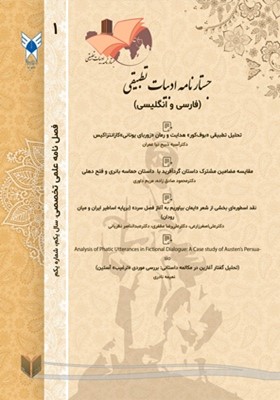تحلیل تطبیقی «بوفکور» هدایت و رمان «زوربای یونانی»کازانتزاکیس
محورهای موضوعی : ادبیات تطبیقی (فارسی- انگلیسی)
1 - دانشیار دانشگاه پیام نور
کلید واژه: ادبیات تطبیقی, بوف کور, رمان انتقادی- فلسفی, زوربا,
چکیده مقاله :
در میان ادبیات داستانی ملل مختلف گاه آثاری یافت می شودکه هم از نظر موضوع و درونمایه و هم از نظر ساختار و نحوة روایت بسیار به یکدیگر شبیهاند. بی گمان آن چه در تعامل و گفت وگوی میان آثار ادبی کشورها میتواند اهمیتی بیش تر داشته باشد، آثاری هستند که در مسیر اقبال و توجه عام و خاص نقشی بنیادین در جریان سازی ادبی و همراهی با تحولات فکری و اجتماعی ملّت خویش دارند. رمان ِمشهور زوربای یونانی(1946م) نوشتة نیکوس کازانتزاکیس(1883- 1957م) و بوف کور صادق هدایت در ادبیات ایران، در این جایگاه ادبی قرار دارند. بنابر اهمیت این دو رمان در ادبیات داستانی یونان و ایران و شباهت های کم نظیر ساختاری و محتوایی میان آن دو و اقبال گستردة نویسندگان و خوانندگان حرفهای و دانشگاهی در دو کشور تلاش شده تا با رویکرد تحلیلی- تطبیقی به واکاوی این دو اثر بپردازیم. از نتایج تحقیق برمی آید که دو رمان یادشده هم از نظر روایت خیام وار و انتقادی یا بدبینانه به زندگی و گرایش شدید به انزوا و مرگ اندیشی و هم از نظر ساختاری و روایتگری بسیار به یکدیگر شبیه هستند.
Literary fictions of different nations can be very similar to each other in terms of both subject matter and themes, and structure and narrative style. No doubt, those works which have successfully gained the attention of their audience and have been fundamental in creating literary movements, in line with the intellectual and social changes of their societies, can play a significant role in establishing dialogical interaction among literary works of various nations. Zorba the Greek (1946), the famous novel by Nikos Kazantzakis (1883-1957) and the Blind Owl by Sadegh Hedayat are in fact among these literary works. Given the significance of these two novels in the Greek and Persian Literature, the distinctive structural and thematic similarities between the two works and also the considerable acclamation earned by the writers and their academic and scholarly readers in the two countries, attempts have been made in this paper to examine these two works through a comparative analytical approach. Results of the analysis suggest that the two novels are substantially similar in terms of their Khayyami narrative style, critical and pessimistic view toward life, strong tendency to solitude and death and narrative and structural aspects.
_||_


